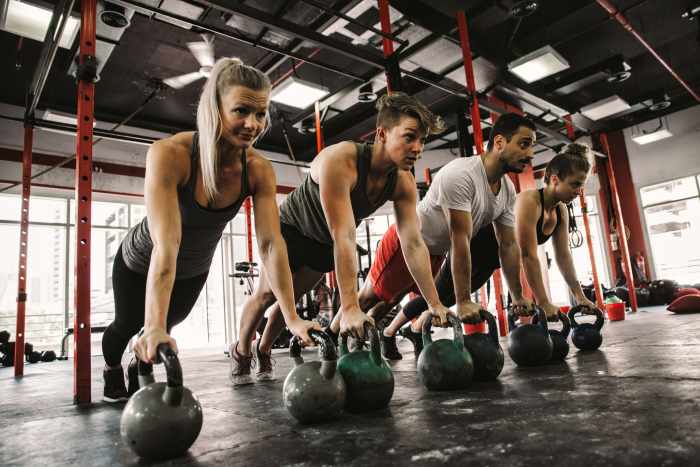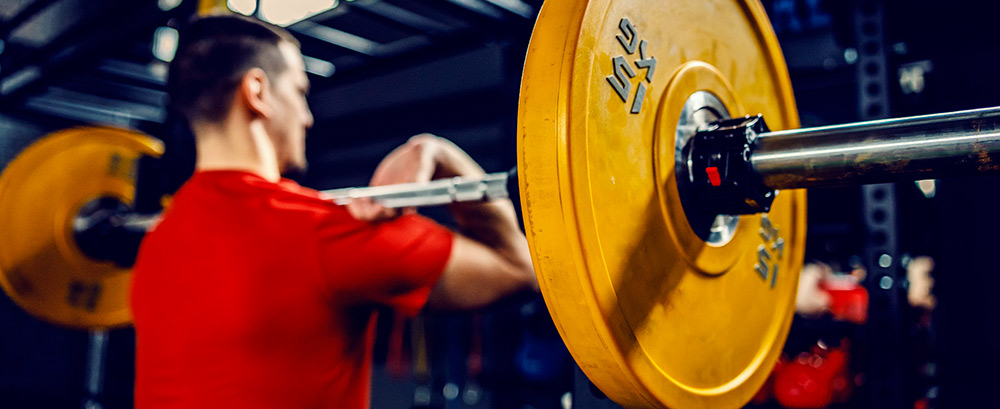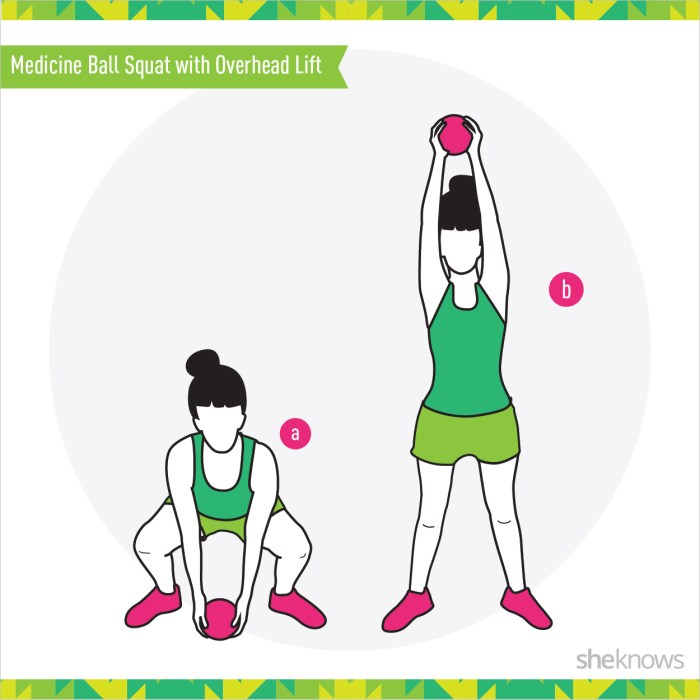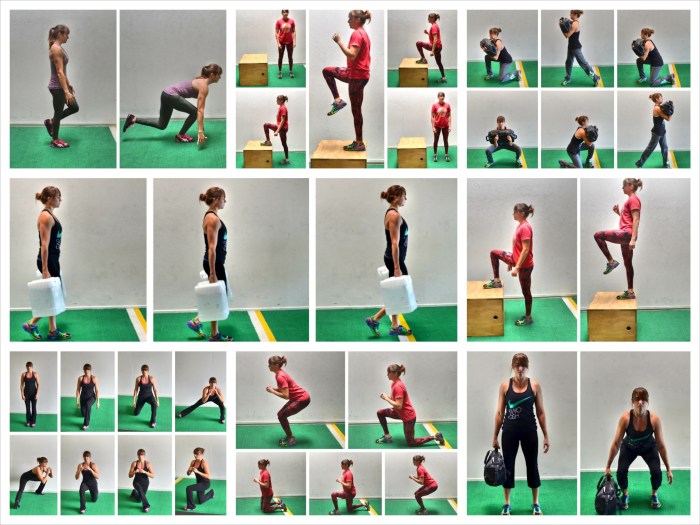Functional Fitness Workouts: Move Better, Feel Stronger

Functional fitness workouts go beyond traditional strength training, focusing on movements that mimic everyday activities and improve your overall physical capabilities. Imagine effortlessly carrying groceries, climbing stairs without strain, or playing with your kids with ease. These are the real-world benefits of functional fitness, which emphasizes practical movements that enhance your daily life.
From mastering fundamental movement patterns like pushing, pulling, squatting, and hinging to incorporating exercises that challenge your balance and coordination, functional fitness workouts offer a comprehensive approach to fitness. By engaging multiple muscle groups simultaneously, these workouts promote strength, power, flexibility, and endurance, contributing to a healthier and more active lifestyle.
Introduction to Functional Fitness Workouts

Functional fitness is a type of exercise that focuses on movements that mimic real-life activities. It aims to improve your ability to perform everyday tasks with ease and efficiency. Unlike traditional strength training, which isolates specific muscle groups, functional fitness emphasizes compound movements that engage multiple muscle groups simultaneously.
Benefits of Functional Fitness
Functional fitness offers numerous benefits that extend beyond physical strength. It improves your overall well-being and enhances your ability to perform daily activities with greater ease.
- Improved Balance and Coordination: Functional fitness exercises often involve challenging your balance and coordination, leading to enhanced stability and reduced risk of falls.
- Increased Muscle Strength and Endurance: By engaging multiple muscle groups simultaneously, functional fitness exercises help build strength and endurance throughout your body.
- Enhanced Flexibility and Mobility: Many functional fitness movements incorporate stretches and range-of-motion exercises, promoting flexibility and joint mobility.
- Reduced Risk of Injuries: By strengthening core muscles and improving overall stability, functional fitness can help prevent injuries from everyday activities or during exercise.
- Improved Cardiovascular Health: Functional fitness exercises can elevate your heart rate and improve cardiovascular health, similar to traditional cardio workouts.
- Weight Management: Functional fitness workouts can help you burn calories and manage your weight effectively.
Difference Between Functional Fitness and Traditional Strength Training
Functional fitness and traditional strength training have distinct approaches to exercise.
- Focus: Functional fitness focuses on movements that mimic real-life activities, while traditional strength training emphasizes isolating specific muscle groups.
- Exercises: Functional fitness exercises often involve compound movements, engaging multiple muscle groups simultaneously. Traditional strength training typically uses isolation exercises, targeting individual muscles.
- Equipment: Functional fitness workouts can utilize a wide range of equipment, including body weights, resistance bands, kettlebells, and medicine balls. Traditional strength training often relies on weight machines and free weights.
- Goal: Functional fitness aims to improve your ability to perform everyday tasks and enhance overall fitness. Traditional strength training focuses on building muscle mass and increasing strength.
Real-World Applications of Functional Fitness Exercises
Functional fitness exercises have practical applications that translate directly to real-life situations.
- Everyday Activities: Functional fitness exercises can improve your ability to carry groceries, climb stairs, lift heavy objects, and perform other daily tasks with ease.
- Sports Performance: Functional fitness exercises can enhance athletic performance by improving strength, power, balance, and coordination, which are crucial for many sports.
- Injury Rehabilitation: Functional fitness exercises can be used in rehabilitation programs to help individuals regain strength, mobility, and balance after injuries.
Key Components of Functional Fitness Workouts

Functional fitness workouts are designed to improve your ability to perform everyday activities with ease and efficiency. They focus on strengthening and conditioning the muscles you use for daily tasks, such as lifting, carrying, pushing, pulling, and balancing.
Movement Patterns in Functional Fitness
Functional fitness workouts typically incorporate a variety of movement patterns that mimic real-life movements. These patterns are essential for developing overall strength, power, and coordination.
- Pushing: This movement pattern involves pushing a weight or object away from your body. Examples include push-ups, bench presses, and overhead presses.
- Pulling: This movement pattern involves pulling a weight or object towards your body. Examples include pull-ups, rows, and lat pulldowns.
- Squatting: This movement pattern involves lowering your body by bending your knees and hips. Examples include squats, lunges, and box squats.
- Hinging: This movement pattern involves bending at the hips, and keeping your back straight. Examples include deadlifts, good mornings, and Romanian deadlifts.
- Rotational Movements: These movements involve rotating your torso or limbs. Examples include wood chops, Russian twists, and medicine ball throws.
Importance of Proper Form and Technique
Proper form and technique are crucial in functional fitness to prevent injuries and maximize results.
Maintaining proper form ensures that you are targeting the correct muscles and using the right movement patterns.
- Focus on Quality over Quantity: Prioritize proper form over lifting heavy weights or performing a high number of repetitions.
- Engage Your Core: A strong core is essential for stability and balance during functional movements.
- Control the Movement: Avoid jerking or swinging the weight. Move the weight smoothly and under control throughout the entire range of motion.
- Listen to Your Body: Pay attention to any pain or discomfort during your workouts. Stop the exercise if you feel any sharp or intense pain.
Designing Functional Fitness Workouts
Designing functional fitness workouts involves creating routines that incorporate various movement patterns and exercises, aiming to enhance everyday activities and improve overall fitness. It’s crucial to consider individual fitness levels, goals, and preferences while designing these workouts.
Sample Workout Routine
A sample functional fitness workout routine can be structured as follows:
- Warm-up:5-10 minutes of light cardio, dynamic stretching, and mobility exercises. Examples include jumping jacks, arm circles, leg swings, and torso twists.
- Workout:3-4 rounds of the following exercises:
- Squat to overhead press:10-15 repetitions
- Push-ups:10-15 repetitions
- Rowing:10-15 repetitions
- Deadlifts:5-10 repetitions
- Plank:30-60 seconds
- Cool-down:5-10 minutes of static stretching, focusing on major muscle groups.
Progression and Variation in Functional Fitness Workouts
Progression and variation are essential aspects of functional fitness workouts. They help prevent plateaus, maintain motivation, and ensure continuous improvement.
- Progression: Gradually increasing the intensity, duration, or complexity of workouts over time. This can involve adding weight, increasing repetitions, reducing rest periods, or introducing new exercises.
- Variation: Incorporating different exercises, movement patterns, and training methods to challenge the body in new ways. This can involve switching between different types of squats, deadlifts, or rows, or using resistance bands, kettlebells, or other equipment.
Adjusting Workout Intensity and Duration
The intensity and duration of functional fitness workouts should be tailored to individual fitness levels and goals.
- Fitness Level: Beginners should start with shorter workouts and lower-intensity exercises, gradually increasing as they gain strength and endurance. Advanced individuals can incorporate more challenging exercises, higher repetitions, and longer workout durations.
- Goals: The intensity and duration of workouts should be aligned with specific goals. For example, those aiming for weight loss might focus on longer, higher-intensity workouts, while those seeking muscle gain might prioritize shorter, heavier workouts.
Functional Fitness Equipment

Functional fitness workouts often utilize a variety of equipment to enhance the effectiveness and challenge of exercises. These tools help target different muscle groups, improve strength, and enhance overall fitness.
Understanding the advantages and disadvantages of each type of equipment can help you choose the best tools for your fitness goals and preferences.
Kettlebells, Functional fitness workouts
There are cast-iron weights with a handle, allowing for a wide range of exercises that engage multiple muscle groups simultaneously.
Kettlebells are versatile and effective for developing strength, power, and cardiovascular fitness. They are particularly beneficial for enhancing core stability and improving functional movement patterns.
- Exercises: Kettlebell swings, snatches, cleans, squats, lunges, Turkish get-ups, and presses.
- Pros: Kettlebells offer a dynamic and challenging workout, promoting functional movements and improving overall fitness.
- Cons: Kettlebells require proper technique to avoid injuries, and may not be suitable for beginners or individuals with limited mobility.
Dumbbells
Dumbbells are free weights that can be used for a wide variety of exercises, targeting specific muscle groups or engaging multiple muscle groups simultaneously.
They are versatile and adaptable, allowing for a wide range of exercises that cater to different fitness levels and goals. They are particularly beneficial for developing strength, muscle mass, and overall fitness.
- Exercises: Bicep curls, tricep extensions, shoulder presses, squats, lunges, rows, and deadlifts.
- Pros: Dumbbells offer a versatile and effective workout, promoting strength and muscle growth. They are relatively safe and easy to use, making them suitable for beginners and experienced lifters alike.
- Cons: Dumbbells can be bulky and require storage space. They may not be suitable for high-intensity workouts or exercises requiring rapid movements.
Resistance Bands
Resistance bands are elastic bands that provide resistance during exercises, enhancing muscle activation and promoting strength and flexibility.
These are portable, versatile, and adaptable, making them suitable for various exercises and fitness levels. They are particularly beneficial for improving flexibility, strength, and endurance.
- Exercises: Band pull-aparts, rows, squats, lunges, chest presses, and bicep curls.
- Pros: Resistance bands offer a low-impact workout, promoting flexibility and strength. They are portable and affordable, making them convenient for home workouts.
- Cons: Resistance bands may not provide sufficient resistance for advanced lifters. They can also be challenging to use for certain exercises.
Suspension Trainers
Suspension trainers are straps that hang from a fixed point, allowing for a wide range of bodyweight exercises that engage multiple muscle groups.
They offer a challenging and effective workout, promoting strength, flexibility, and core stability. They are particularly beneficial for improving functional movements and enhancing overall fitness.
- Exercises: Rows, pull-ups, push-ups, squats, lunges, and core work.
- Pros: Suspension trainers offer a versatile and challenging workout, engaging multiple muscle groups simultaneously. They are portable and affordable, making them convenient for home workouts.
- Cons: Suspension trainers require proper technique to avoid injuries. They may not be suitable for beginners or individuals with limited mobility.
Benefits of Functional Fitness Workouts
Functional fitness workouts offer a wide range of benefits that extend beyond just physical improvements. They enhance your overall well-being by strengthening your body, mind, and spirit, preparing you for the demands of daily life and beyond.
Physical Benefits
Functional fitness workouts focus on movements that mimic everyday activities, resulting in improved strength, power, flexibility, balance, and coordination. These benefits translate into better performance in daily tasks, reduced risk of injuries, and enhanced overall physical capacity.
- Increased Strength and Power: Functional exercises engage multiple muscle groups simultaneously, promoting overall strength and power development. This enhanced strength translates into easier execution of daily tasks like carrying groceries, climbing stairs, and lifting objects.
- Improved Flexibility and Range of Motion: Functional exercises often involve a full range of motion, enhancing flexibility and improving joint mobility. This improved flexibility can reduce the risk of injuries and improve posture, making it easier to perform everyday activities.
- Enhanced Balance and Coordination: Many functional exercises require balance and coordination, improving your ability to maintain stability and control your movements. This enhanced balance and coordination are crucial for activities like walking, running, and navigating uneven surfaces, reducing the risk of falls.
- Reduced Risk of Injuries: By strengthening muscles and improving flexibility and balance, functional fitness workouts help prevent injuries. Strong muscles and joints are less susceptible to strains and sprains, making it easier to perform daily activities without getting hurt.
Mental and Emotional Benefits
Functional fitness workouts can positively impact your mental and emotional well-being, fostering a sense of accomplishment, reducing stress, and improving mood. The physical benefits of functional fitness, such as improved strength and flexibility, contribute to a positive self-image and increased confidence.
- Increased Confidence: As you progress in your functional fitness journey, you gain strength and improve your ability to perform challenging movements. This newfound confidence extends beyond the gym, boosting your self-esteem and overall well-being.
- Reduced Stress: Exercise, in general, is a powerful stress reliever. Functional fitness workouts, with their focus on controlled movements and mindful engagement, can be particularly effective in reducing stress and promoting relaxation. Engaging in these workouts can help you clear your mind and de-stress after a long day.
- Improved Mood: Functional fitness workouts release endorphins, which have mood-boosting effects. Regular participation in these workouts can lead to improved mood, reduced feelings of anxiety, and a more positive outlook on life.
Enhanced Daily Life Activities
The benefits of functional fitness extend far beyond the gym, enhancing your ability to perform everyday activities with greater ease and efficiency.
- Easier Household Chores: Functional fitness improves your strength, flexibility, and balance, making household chores like lifting heavy objects, cleaning, and gardening easier and less strenuous.
- Improved Mobility: Functional exercises strengthen muscles responsible for movement, improving mobility and making it easier to navigate stairs, walk longer distances, and participate in active hobbies.
- Increased Independence: As you age, maintaining physical strength and mobility becomes increasingly important for independent living. Functional fitness helps you stay active and independent, enabling you to perform daily tasks without assistance.
Incorporating Functional Fitness into Your Routine
Integrating functional fitness exercises into your existing workout routine can significantly enhance your overall fitness and well-being. By incorporating exercises that mimic real-life movements, you can improve your strength, flexibility, balance, and coordination, making everyday activities easier and more enjoyable.
Integrating Functional Fitness Exercises
You can seamlessly integrate functional fitness exercises into your existing workout routine without disrupting your current training plan. Here are some tips for incorporating functional fitness:
- Start with a few exercises: Begin by adding one or two functional fitness exercises to your current routine, gradually increasing the number as you progress.
- Replace similar exercises: Substitute traditional exercises with functional alternatives, such as replacing bicep curls with farmer’s carries or squats with lunges.
- Use bodyweight exercises: Bodyweight exercises like push-ups, squats, lunges, and planks are excellent functional fitness exercises that can be easily incorporated into any routine.
- Focus on compound movements: Compound exercises like deadlifts, squats, and rows engage multiple muscle groups, providing a more efficient and effective workout.
- Incorporate functional exercises into cardio workouts: Add functional movements like burpees, mountain climbers, or jumping jacks to your cardio routine to increase intensity and engagement.
Importance of Proper Warm-up and Cool-down Routines
Warming up and cooling down are essential parts of any workout routine, but they are particularly crucial for functional fitness exercises. A proper warm-up prepares your body for the demands of the workout, reducing the risk of injury, while a cool-down helps your body recover and prevents muscle soreness.
- Warm-up: A dynamic warm-up, involving light cardio and dynamic stretching, is ideal for preparing your body for functional fitness exercises. This could include light jogging, arm circles, leg swings, and torso twists.
- Cool-down: A cool-down should focus on static stretching, holding each stretch for 15-30 seconds. This helps improve flexibility and reduce muscle stiffness.
Finding a Qualified Functional Fitness Professional
Finding a qualified functional fitness professional is essential for maximizing the benefits of your training. A qualified professional can assess your fitness level, design personalized workouts, and provide proper guidance and supervision to ensure your safety and effectiveness.
- Seek certifications: Look for professionals certified by reputable organizations like the National Academy of Sports Medicine (NASM) or the American Council on Exercise (ACE) in functional fitness or strength and conditioning.
- Consider experience: Choose a professional with experience in functional fitness and a proven track record of success.
- Ask for referrals: Seek recommendations from friends, family, or other fitness professionals.
- Schedule a consultation: Before committing to a trainer, schedule a consultation to discuss your fitness goals, experience, and any injuries or limitations.
Functional Fitness for Specific Populations

Functional fitness can be tailored to meet the unique needs of different individuals, making it a valuable approach for diverse populations. By understanding the specific benefits and considerations for each group, you can create effective and safe workout programs.
Functional Fitness for Different Age Groups
This is beneficial across all age groups, offering a wide range of advantages.
- Children and Adolescents: Functional fitness can help develop fundamental movement skills, improve coordination, and enhance overall physical literacy. It can also foster a positive relationship with physical activity and encourage healthy habits.
- Adults: For adults, functional fitness helps maintain strength, flexibility, and balance, reducing the risk of falls and injuries. It can also improve cardiovascular health, increase bone density, and enhance overall well-being.
- Older Adults: As individuals age, functional fitness becomes particularly important. It helps preserve independence, improve mobility, and enhance quality of life. Exercises that focus on balance, strength, and flexibility are crucial for maintaining functional independence and reducing the risk of age-related decline.
Functional Fitness for Individuals with Specific Health Conditions or Injuries
This can be adapted to accommodate individuals with various health conditions or injuries, promoting safe and effective exercise.
- Cardiovascular Disease: Functional fitness exercises can help improve cardiovascular health by strengthening the heart and lungs, reducing blood pressure, and improving cholesterol levels. It is essential to consult with a healthcare professional before starting any exercise program, especially if you have cardiovascular disease.
- Arthritis: Functional fitness can help manage pain and improve joint mobility in individuals with arthritis. Exercises that focus on strengthening muscles around the joints and improving flexibility can be beneficial. It is important to choose exercises that are appropriate for your specific condition and to listen to your body.
- Obesity: Functional fitness can help individuals with obesity lose weight and improve overall health. Exercises that combine cardiovascular activity with strength training are particularly effective for weight loss and improving body composition.
- Back Pain: Functional fitness can help strengthen core muscles and improve posture, reducing the risk of back pain and improving recovery from injuries. It is important to choose exercises that do not exacerbate pain and to consult with a healthcare professional if you have persistent back pain.
Examples of Functional Fitness Exercises for Pregnant Women or Older Adults
Functional fitness exercises can be modified to accommodate the unique needs of pregnant women and older adults.
- Pregnant Women:
- Modified Squats: Stand with feet shoulder-width apart and lower your body by bending your knees and keeping your back straight. You can use a chair or wall for support if needed.
- Wall Push-Ups: Stand facing a wall with your hands shoulder-width apart and slightly lower than shoulder height. Lean forward and push off the wall to return to the starting position.
- Modified Plank: Start in a plank position with your forearms on the ground and your body in a straight line. You can modify this exercise by lowering your knees to the ground.
- Older Adults:
- Chair Sit-to-Stand: Sit on a sturdy chair with your feet flat on the floor. Stand up and sit down again, maintaining a controlled movement.
- Heel Raises: Stand with your feet shoulder-width apart and raise up onto your toes, holding for a few seconds before lowering back down.
- Walking Lunges: Take a step forward with one leg and lower your body until your front knee is bent at a 90-degree angle. Step forward with the other leg and repeat.
Ultimate Conclusion

Whether you’re a seasoned athlete seeking to enhance performance or a beginner looking to improve your overall well-being, functional fitness workouts offer a path to a stronger, more functional body. By incorporating these exercises into your routine, you can unlock your full potential and experience the transformative power of movement.
Remember to focus on proper form, listen to your body, and progressively challenge yourself to reap the numerous benefits of functional fitness.
Comments are closed.